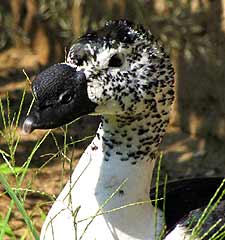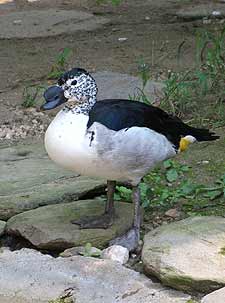![]() Wild animals are not pets
Wild animals are not pets
[The Namibian
– March 2011]
 |
The characteristic knob of the male comb duck |
Seasons of extreme weather always produce something new. In the last week of February a comb duck, also known as a knob-billed duck, arrived in Walvis Bay. This is an extremely rare event, probably the first record of this species on our coast. The duck landed in a garden and was promptly trapped by the homeowner who chopped off all the flying feathers on both its wings. The homeowner’s reason was that he had other domestic ducks and wanted to add this bird to his garden flock. However, in no time this wild male bird, stressed and unused to the surrounds, fought with the domestic ducks and was then given up to a local environmentalist.
Once rendered flightless, a wild bird cannot fend for itself. The moult of all primary and secondary flying feathers may only happen once a year. At this time of year many comb ducks have completed their annual moult. If this is the case for the rescued bird, it will require captive care for another year until a new set of flight feathers has grown.
 |
A male comb duck (Sarkidiornis melanotos) |
Comb ducks belong to the family anatidae. Although common in some parts of southern Africa, they are not that common in Namibia. This beautiful bird has iridescent black plumage above with white below and a white head and neck speckled with black. The special character of the male comb duck is a knob on the top of its bill. These intra-African migrants are a tropical species moving between southern and equatorial Africa. They prefer seasonally flooded pans and flood plains with shallow marshy areas of clear water.
The story of the first record of a species in an area could have been simply an interesting note for a local newspaper and a birding newsletter. However, the story is now also an example of the misconceptions that many members of the Namibian public and other people have about wildlife and ownership of wild animals. This situation also raises questions concerning standards of care and cruelty to animals. In the case of birds, flying feathers are used for flight and also cover parts of the body, functioning as water-proofing and insulation.
Through ignorance of national wildlife laws and regulations and a misunderstanding of the difference between wildlife and domestic animals the unfortunate, now flightless, comb duck will probably spend at least a year in captivity at NARREC (The Namibia Animal Rehabilitation Research and Education Centre). If the bird had been rescued and immediately given over to environmentalists it could have been transported inland to an appropriate site and its traumatic experience would have lasted only hours or days. What should have been a short stay in captivity for this bird is now a long, tedious and costly affair.
In Namibia, because wildlife is abundant, this story is not that unusual. Many people with little knowledge or real rationale want to keep and tame wild animals. In some cases this is simply for the novelty but in many cases there is an underlying expectation of reward. This is especially true at many local lodges and game farms where a habituated wild animal is a potential talking point for attracting and impressing visitors.
The Ministry of Environment and Tourism is perhaps to some extent guilty of not promoting its regulations and setting a zero tolerance approach for inappropriate captive situations. All countries have regulations on who may keep captive wildlife, together with when, why and how a captive environment is acceptable. Aviculture, the practice of keeping birds has some complex and questionable standards and ethics. From avicultural history it has become an accepted norm to render pet birds flightless or to keep them in very small cages. Although historically many animal species were subject to captive environments and conditions that are today viewed as completely unethical, acceptable standards for birds have changed very little throughout most of the world. But for now, Namibia does have well described regulations on the capture and holding of at least our indigenous avifauna and all Namibians should adhere to these for the safe future of our biodiversity.
 Liz
Komen
Liz
Komen
NARREC